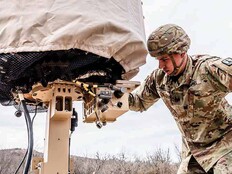HHS Uses AI Tools to Help Battle Diseases
Artificial intelligence can be used in government for a whole lot more than just chatbots.
The Department of Health and Human Services in January concluded a 14-week technology sprint known as The Opportunity Project (TOP) Health sprint. During the sprint, 10 teams delivered digital tools that were built with federal data and AI to enhance medical testing, explore new kinds of treatment and improve care via analytics for a variety of diseases. Federal agencies partnered with private sector organizations on the project, including Microsoft and Oracle.
“At HHS, we recognize that Federal government alone cannot solve our most important and complex challenges,” HHS CTO Ed Simcox said in a blog post, adding, “the TOP Health sprint is a valuable step in leveraging skills from industry with public resources to promote better health outcomes.”
HHS also conducted the project with the Presidential Innovation Fellows (PIF), a program run by the General Services Administration. This past week, HHS released more information on one of the key challenges the sprint identified: AI approaches for facilitating an experimental therapy ecosystem. The challenge, according to the HHS blog post, sought to answer the question, how can we do better by leveraging standards and emerging technologies?
According to HHS, the program led to new insights on how sharing federal data with the private sector could be encouraged and monitored. Agencies were “interested in understanding and customizing datasets for various use cases, but were primarily focusing on internal government use,” according to a separate HHS blog post. And, the agency says, the “lightweight collaboration through TOP Health strengthened the intersection of government and industry.”
Joshua Di Frances, executive director of the PIF program, said in a blog post that this collaboration across agencies and private companies shows there are new avenues for combining open federal data and AI technologies. “Through incentivizing links between government and industry via a bidirectional AI ecosystem, we can help promote usable, actionable data that benefits the American people,” he said.
MORE FROM FEDTECH: Find out how robotic process automation will help agencies.
HHS Turns to AI to Get Insights and Help Patients
According to a blog post by Gil Alterovitz, a research affiliate with the Veterans Affairs Department, and Kristen Honey, innovator in residence at HHS’ office of the CTO, agencies and patient advocates who worked together on AI projects largely said that the sprint “allowed for an open exchange of ideas and the opportunity for further collaboration between the U.S. government and private sector companies.”
By January 2019, seven TOP Health teams had delivered digital tools. The teams used data from the open-data portal data.gov to “create digital products, apps and gamification inventions to improve clinical trials, experimental therapies, and data-driven solutions for complex challenges from cancer to Lyme and tick-borne diseases,” Alterovitz and Honey said.
Among the tools was the Microsoft Healthcare Bot built by Microsoft Healthcare in Israel. The tool aims to “democratize clinical trials matching by helping patients and doctors find suitable trials quickly and easily” through conversational AI, advanced machine reading on clinical trials eligibility criteria, natural language processing and smart qualification.
The Energy Department’s Oak Ridge National Laboratory had its SmartClinicalTrials team work on “a large knowledge graph representation for cancer clinical trials to enable discovery of new concepts from unstructured text.”
And, Oracle Public Sector and Oracle Healthcare built a patient-centric solution for clinical trial matching. The solution matches patients battling cancer with clinical trial programs and uses AI to “provide a more simplified and personalized experience for determining treatment.”
The private sector was looking to “minimize risk” when choosing which data sets to use among the vast quantities of available federal data, Alterovitz and Honey said. “Through the TOP Health process, multiple high-value datasets were unlocked from over a dozen collaborating agencies/departments.”
Agencies Work with HHS to Provide Open Data
Several agencies were involved with TOP. The U.S. Patent and Trademark Office, for instance, assembled a large set of invention topics to help inspire prospective inventors, including those with applications in the AI ecosystem and experimental therapeutics space.
The VA offered access to de-identified cancer patients for use in matching to trials/therapeutics and analytical tools for AI and machine learning.
HHS says the AI work allowed researchers to create new data sets, and they were able to derive fresh insights from the data. For example, the National Cancer Institute, which is part of the National Institutes of Health, “generated three new data sets including data on: structured eligibility criteria, participants based on call samples to contact center, and medical professional-curated participant/trial match rating,” according to the HHS blog post. NCI also provided medical professional curation to make data sets and give guidance.
At the end of the day, the program is about helping patients, and HHS said user-centered feedback from a wide range of individuals guided the development of all the digital tools.
For example, patient advocates such as Stephen Aldrich, the 63-year-old founder and former CEO of Bio Economic Research Associates, a private research and advisory firm, provided valuable feedback and perspective.
Aldrich was diagnosed with metastatic stage 4 adenocarcinoma of the esophagus in late March 2017. “My response to my fatal cancer diagnosis served as an inspirational case study for the sprint group,” Aldrich said, adding that he is hopeful for the future of experimental therapeutics via AI and open data.
“I am extremely grateful to live at a time when what used to be a terminal cancer diagnosis can be turned into something much less threatening due, in no small part, to our exploding ability to gather and analyze personal genomic information,” Aldrich said. “I envision a day when all cancer patients have had their cancers fully sequenced, and enjoy direct control over their fundamental genomic and health data, enabling them to quickly identify the best potential treatment options for their unique cancers. Amazing cures are possible, if we enable them to happen.”










